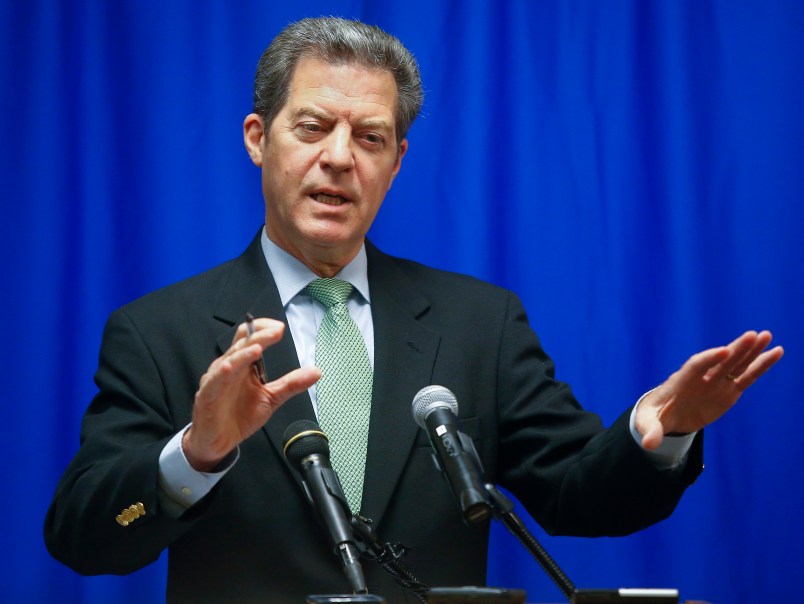UPDATE: June 17, 2015, 10:09 AM EDT
TOPEKA, Kan. (AP) — Republican Gov. Sam Brownback said Tuesday that Kansas isn’t really increasing taxes even though the state will raise its sales and cigarette taxes to balance the budget.
Only hours after defending the legislation during a Statehouse news conference, Brownback announced he had signed two bills that together raise $384 million during the fiscal year that begins July 1, to avert a deficit. The state’s sales tax will rise to 6.5 percent from 6.15 percent, and the cigarette tax will jump by 50 cents a pack, to $1.29.
The governor said this year’s tax increases must be viewed in light of aggressive personal income tax cuts enacted by the GOP-dominated Legislature at his urging in 2012 and 2013 to stimulate the economy. His aides distributed figures showing that those income tax cuts would be worth nearly $1 billion during the next fiscal year.
The state’s budget problems arose after those income tax cuts, and disagreements among Republican legislators over closing the deficit made this year’s annual session the longest in state history, at 113 days. Brownback said while some critics “would have you believe” the state is raising taxes, “that is not accurate.”
“You’ve got to look at the totality of the picture,” he told reporters. “When you look at that, it is a tax cut, and you’ve dealt with your major problems in state government.”
Brownback, his top aides and their legislative allies have argued repeatedly that cuts in income tax rates benefited all classes of taxpayers. The governor noted that one provision of this year’s tax legislation will exempt 388,000 low-income Kansans, starting in 2016.
But a new analysis Tuesday from Institute for Taxation and Economic Policy, a nonpartisan but left-leaning policy group based in Washington, said the cumulative effects of the changes in tax policy since 2012 have benefited the state’s wealthiest residents the most, while increasing taxes for its poorest residents.
The analysis posted online said the poorest 20 percent of the state’s residents will pay 1.5 percent more in taxes than they did in 2012, or an average of $197 a year. Meanwhile, the wealthiest 1 percent will pay 1.9 percent less, or an average of about $24,600, the group said.
Senate Minority Leader Anthony Hensley said this year’s tax increases show that the governor’s economic policies are a failure and predicted that that the state will continue to experience “a self-inflicted budget crisis for years to come.”
“Governor Brownback is incapable of telling the truth,” Hensley, a Topeka Democrat, said in a statement. “Not only is this a tax increase, it is the largest tax increase in state history.”
Brownback also announced that he signed a bill containing the bulk of the state’s $15.4 billion budget for the next fiscal year, vetoing a single, $1.9 million higher education item that the state Board of Regents said wasn’t necessary.
Republican legislators who drafted the tax legislation anticipate that Brownback might have to cut another $50 million in spending to ensure that the state has a cushion of cash reserves going into July 2016. Brownback said he his administration would look for efficiencies.
___
Online:
Summary of first tax bill: http://bit.ly/1F3xHBu
Summary of the second bill, which modifies the first: http://bit.ly/1KOuw7V
___
Follow John Hanna on Twitter at https://twitter.com/apjdhanna
Copyright 2015 The Associated Press. All rights reserved. This material may not be published, broadcast, rewritten or redistributed.







This reminds me of the “I’m not touching you” game we used to play in the back seat of the car on long trips as children, holding a finger out just barely not touching your sibling and saying “I’m not touching you” over and over to tease the shit out of them until you get yelled at to “cut it out back there!!!” FUCKING. CHILDISH.
“You’ve got to look at the totality of the picture,”
And here it is:
“the poorest 20 percent of the state’s residents will pay 1.5 percent more in taxes than they did in 2012, or an average of $197 a year. Meanwhile, the wealthiest 1 percent will pay 1.9 percent less, or an average of about $24,600”
Any questions?
Kansas is about 3M people. 20% is 600,000 and 1% is 30,000. Math time:
600,000 x $200 = $120M
30,000 x -$25,000 = -$750M
So the poor have been asked to not only subsidize massive $750M tax cuts for the wealthiest to the tune of $120M BUT ALSO to suffer all the cuts to things like public education, programs to assist the poor, etc., that fund the other $630M.
Edit: Changed per correction below.
Yeah, don’t worry Kansas. You know that thing that’s fucking up our state on an unimaginable scale? We’re still fully committed to that. Just making some adjustments.
And oher than state, federal and local taxes, I pay no taxes at all.
Ah, the governor of KansASS is lyin’ for the Lord again!
Next up, Sammy will go on Fox News to say that he’s increased the chocolate rations for everyone in KansASS from 10 to 5 grams!